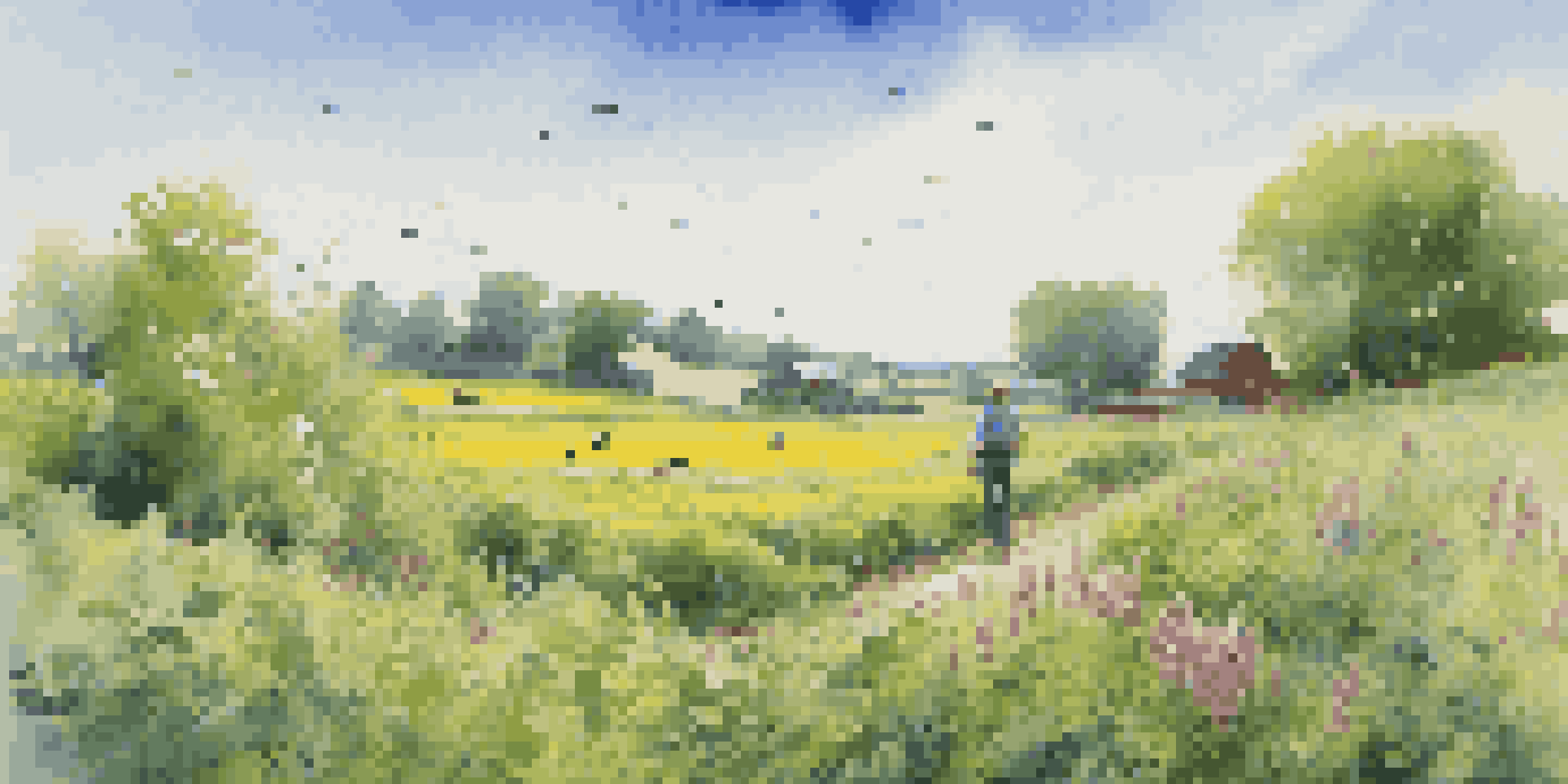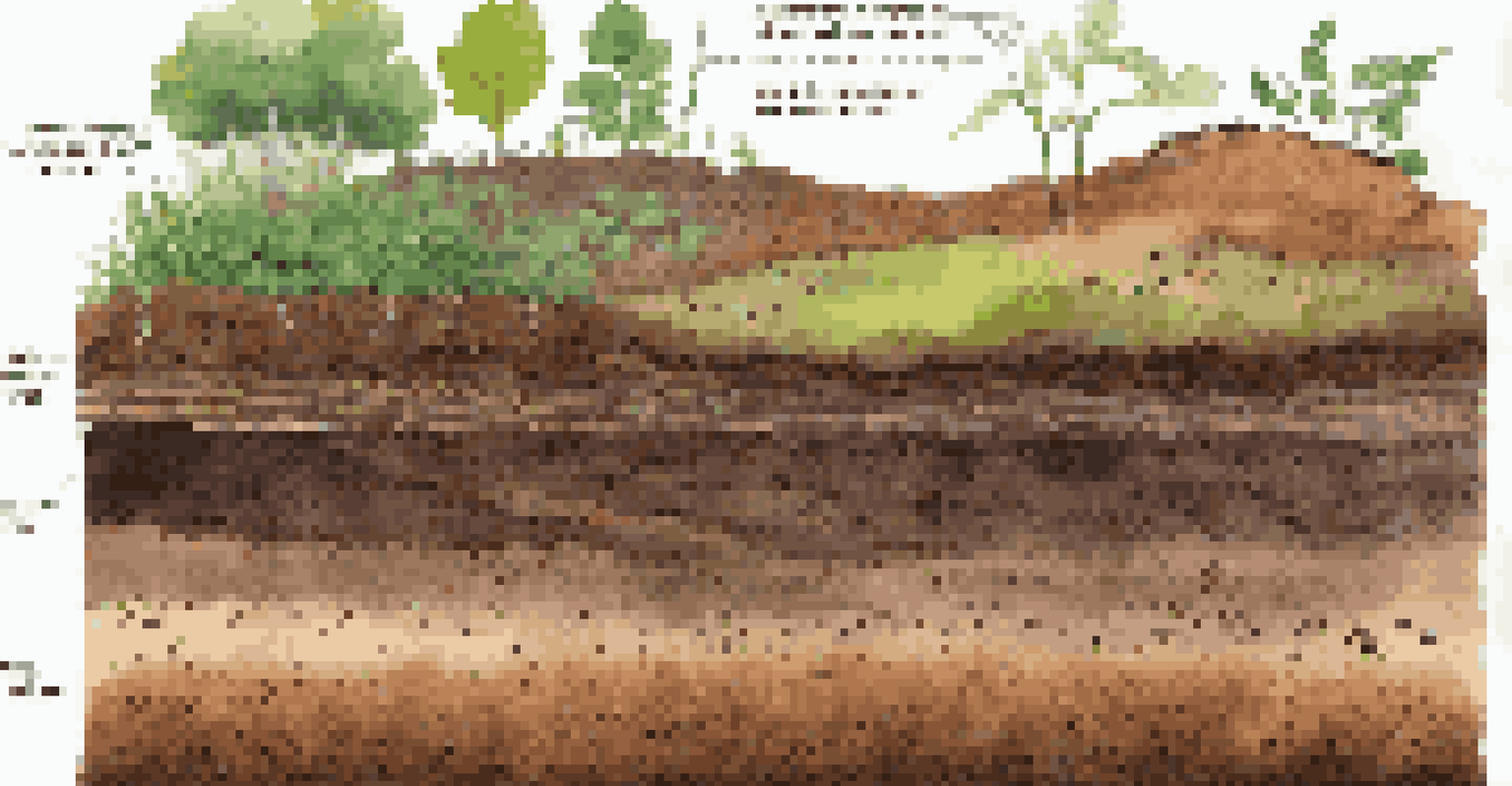Benefits of Planting Cover Crops for Wildlife Health

Understanding Cover Crops and Their Purpose
Cover crops are plants grown primarily to improve soil health and prevent erosion. They are not harvested for profit but rather serve multiple ecological functions. Farmers often plant them in the off-season to protect the soil and enhance its nutrients, which ultimately benefits wildlife. By creating a more stable ecosystem, cover crops contribute to a thriving habitat for various species.
Healthy soil is the foundation of a thriving ecosystem.
When considering wildlife health, cover crops can be a game changer. They provide food sources and shelter for many animals, from insects to larger mammals. For instance, clover and vetch can attract pollinators, while grasses may offer nesting sites for birds. This interconnectedness illustrates the importance of cover crops beyond just agricultural benefits.
In essence, cover crops help create a more balanced ecosystem. By improving soil quality and offering resources for wildlife, they play a crucial role in maintaining biodiversity. This practice aligns farming with conservation, paving the way for healthier wildlife populations.
Enhancing Soil Quality for Wildlife Benefit
Healthy soil is the foundation of a thriving ecosystem, and cover crops are vital in achieving this. They enhance soil structure, improve water retention, and increase organic matter, which ultimately leads to better plant growth. For wildlife, this means more abundant food sources, as healthier plants can sustain a greater variety of species.

Moreover, as cover crops decompose, they release nutrients back into the soil. This process not only benefits future crops but also supports the growth of wild plants that serve as food and shelter for wildlife. Think of it as a natural buffet for animals that rely on diverse vegetation for their survival.
Cover Crops Boost Soil Health
Cover crops significantly improve soil structure and fertility, leading to better plant growth and a sustainable ecosystem.
By promoting soil health through cover crops, farmers can help ensure that local wildlife has the resources it needs. This relationship between agriculture and wildlife can lead to a more sustainable approach to land management, benefiting both farmers and the ecosystem.
Providing Habitat for Diverse Species
Cover crops offer a unique habitat for various wildlife species, creating a sanctuary in agricultural landscapes. This is especially important in areas where natural habitats have been lost due to urbanization or intensive farming. By integrating cover crops into their fields, farmers can help restore habitats for birds, insects, and small mammals.
The best time to plant a tree was twenty years ago. The second best time is now.
For example, fields planted with buckwheat can attract beneficial insects like ladybugs and bees, while fields with rye can provide cover for small rodents. These crops create a network of food and shelter, promoting biodiversity. This increase in species variety can lead to more resilient ecosystems that can better withstand environmental changes.
Ultimately, planting cover crops isn't just about improving soil health; it's also about fostering a thriving wildlife community. By recognizing the value of these plants as habitats, farmers can contribute to a healthier environment for everyone.
Supporting Pollinators Through Cover Crops
Pollinators play a critical role in our ecosystem, and cover crops can significantly support their populations. Plants like clover, buckwheat, and sunflowers are not only beneficial for the soil but also serve as essential food sources for bees and butterflies. By planting these crops, farmers can create a welcoming environment for these vital species.
When farmers diversify their cover crops, they can attract a wider variety of pollinators. This diversity is essential for maintaining healthy ecosystems, as different pollinators have varying roles in plant reproduction. A rich tapestry of flowering cover crops ensures that these creatures have access to food throughout the growing season.
Habitat for Wildlife Restoration
Integrating cover crops into farming practices provides essential food and shelter for diverse wildlife species, promoting biodiversity.
In conclusion, integrating pollinator-friendly cover crops into farming practices can enhance biodiversity and contribute to the overall health of wildlife. By taking this step, farmers not only improve their yields but also support the pollinators that are crucial to our food systems.
Reducing Pesticide Use for Wildlife Safety
Cover crops can help reduce the need for chemical pesticides, which often pose risks to wildlife. By improving soil health and promoting beneficial insects, farmers can naturally control pests. This means less reliance on harmful chemicals that can contaminate nearby habitats and affect wildlife populations.
For instance, planting cover crops can enhance the presence of natural predators, like ladybugs and lacewings, which feed on common agricultural pests. This natural pest control not only benefits farmers by reducing costs but also protects the health of surrounding ecosystems. Wildlife can thrive when their habitats are free from harmful chemicals.
Ultimately, adopting cover crops can lead to a safer environment for all species. By minimizing pesticide use, farmers contribute to the overall health of wildlife populations, creating a more sustainable agricultural system.
Improving Water Quality and Availability
Cover crops play an essential role in improving water quality by reducing runoff and preventing erosion. When planted, these crops create a network of roots that hold the soil together, allowing rainwater to seep into the ground rather than wash away. This process helps filter pollutants and keeps waterways cleaner, benefiting both wildlife and humans.
Moreover, healthier soil retains more water, which can be a lifeline for wildlife during dry periods. This increased water availability ensures that animals have the resources they need to survive during challenging times. Think of cover crops as a natural sponge, soaking up rainwater and releasing it slowly to the surrounding environment.
Support for Pollinators
Planting pollinator-friendly cover crops not only enhances biodiversity but also improves agricultural yields by supporting essential pollinator populations.
By prioritizing cover crops, farmers can contribute to healthier watersheds. This not only supports wildlife but also promotes a more sustainable agricultural practice that benefits the entire community.
Promoting Resilience Against Climate Change
As climate change continues to impact our environment, cover crops can help build resilience in both agriculture and wildlife. By improving soil health and increasing biodiversity, these crops can create a more robust ecosystem capable of withstanding extreme weather events. This resilience is crucial for wildlife populations facing shifting habitats and food sources.
Cover crops also help sequester carbon, reducing greenhouse gases in the atmosphere. This aspect is vital in combating climate change and promoting a healthier planet for all species. By planting cover crops, farmers are not only supporting their crops but also contributing to a more sustainable future.

In summary, integrating cover crops into farming practices can enhance resilience against climate change. This approach supports wildlife health while aligning agricultural practices with environmental sustainability.
Conclusion: The Synergy Between Farming and Wildlife Health
The benefits of planting cover crops extend beyond agricultural success; they significantly impact wildlife health and biodiversity. By understanding the interconnectedness of soil health, water quality, and habitat preservation, farmers can take actionable steps to create a thriving ecosystem. Cover crops represent a bridge between effective farming and wildlife conservation.
As we've explored, cover crops provide essential resources for wildlife, enhance soil quality, and promote resilience against climate change. This synergy helps create a balanced environment where both agriculture and wildlife can flourish. It's a win-win situation that encourages sustainable practices in farming.
Ultimately, the decision to plant cover crops is a commitment to fostering a healthier planet. By prioritizing wildlife health alongside agricultural productivity, we can work towards a more sustainable future for generations to come.